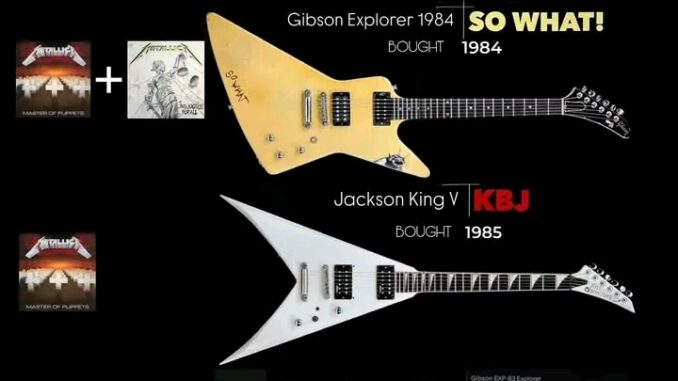
Metal Milestones: James Hetfield Showcases His Legendary Recording Guitars from Metallica’s First Four Albums and Tours — JamesHetfield GibsonExplorer ElectraFlyingV
In a moment that sent shockwaves of nostalgia through the metal community, Metallica frontman James Hetfield has opened up his personal vault, giving fans an exclusive look at the iconic guitars that shaped the band’s earliest and most influential years. From the raw aggression of Kill ’Em All (1983) to the dark precision of …And Justice for All (1988), Hetfield’s collection tells the story of heavy metal’s evolution — through wood, steel, and six strings of pure fire.
—
The Birth of a Sound — The Electra Flying V
The journey begins with Hetfield’s Electra 2236 Flying V, the first guitar that became synonymous with Metallica’s ferocious debut, Kill ’Em All. Purchased before Metallica even had a record deal, this guitar was Hetfield’s weapon of choice during the band’s formative club days in the early 1980s. Its sharp tone and aggressive bite helped define the band’s early thrash sound, pairing perfectly with Hetfield’s galloping right-hand rhythm style.
Fans remember this guitar for its rawness — no fancy paint job, no custom electronics, just unfiltered metal power. It was seen during countless live shows, including Metallica’s early tours supporting Raven and Venom. “That guitar was part of the struggle,” Hetfield once said. “It’s what we had, and it did the job. It helped build the wall of sound that became Metallica.”
—
The Rise of the Explorer — Gibson Takes Over
As Metallica’s sound evolved, so did Hetfield’s choice of instruments. By the time Ride the Lightning (1984) was recorded, Hetfield had discovered the Gibson Explorer, a guitar that would become his visual and sonic trademark. The sharp, angular body mirrored Metallica’s intensity, and the tone — thick, punchy, and defined — perfectly captured the precision and power of tracks like “For Whom the Bell Tolls” and “Creeping Death.”
Hetfield’s white Gibson Explorer, often referred to as “So What!” or simply “the white Explorer,” became an icon in its own right. It was not only used extensively in the studio but also dominated the band’s world tours, including the legendary Ride the Lightning and Master of Puppets runs. Its custom EMG pickups gave Hetfield the tight, crunchy rhythm tone that became a hallmark of Metallica’s sound.
—
Mastery of Metal — The Explorer Legacy Grows
By 1986, as Metallica released Master of Puppets, Hetfield’s Explorers had become extensions of his own identity. Tracks like “Battery,” “Welcome Home (Sanitarium),” and the album’s monumental title track showcased the guitar’s incredible range — from clean arpeggios to bone-crushing riffs. The combination of Hetfield’s downpicking technique and the Explorer’s natural resonance forged one of the most distinctive rhythm guitar sounds in rock history.
On stage, fans witnessed Hetfield leading the band like a general, Explorer slung low, commanding the crowd with precision and presence. Every riff, every chord, every headbang was powered by the same guitars that wrote the blueprint for modern metal.
—
Refinement and Revolution — The Justice Era
For …And Justice for All (1988), Hetfield continued his evolution, introducing customized versions of the Explorer and experimenting with tone refinements that matched the band’s increasingly complex compositions. The clean, surgical riffs of “Blackened” and the haunting structures of “One” demanded precision — and Hetfield’s trusted Explorers delivered.
He began working closely with luthiers to fine-tune his guitars, leading to the early development of his signature ESP Explorers, modeled after the classic Gibson design but built for the rigors of heavy touring and recording. These instruments carried Metallica through the monumental Damaged Justice tour, where Hetfield’s rhythm tone reached its most polished and punishing form yet.
—
A Legacy Forged in Steel
Hetfield’s decision to showcase these guitars today isn’t just about nostalgia — it’s a tribute to the instruments that helped forge Metallica’s empire. Each guitar carries its own story: the sweat, the blood, the sound of evolution from garage thrashers to global legends.
In his own words, Hetfield reflected:
> “Each of these guitars represents a chapter in my life — the struggle, the growth, and the sound that defined who we are. They’re battle-scarred, but they’ve survived every riff, every tour, every night. They’re part of the Metallica DNA.”
For fans, this rare glimpse is more than a history lesson. It’s a reminder of the raw energy and authenticity that defined the first four Metallica albums — the records that changed the face of heavy metal forever.
—
From the Electra Flying V to the Gibson Explorer, James Hetfield’s guitars remain symbols of power, precision, and perseverance — the very tools that built the soundtrack of a generation.
Read more for exclusive photos, stories, and behind-the-scenes insights into Hetfield’s legendary collection — a true celebration of metal history. ⚡
Leave a Reply